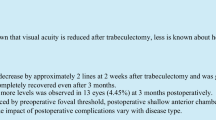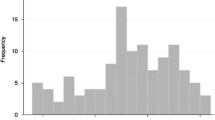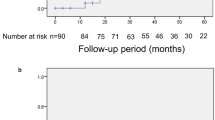Abstract
Purpose
To evaluate progression of visual field (VF) defects and development of visual impairment (low vision and blindness) after trabeculectomy.
Methods
We evaluated retrospectively 138 eyes of 138 consecutive patients over 40 years of age with primary open-angle glaucoma (POAG) or exfoliation glaucoma (EG) operated on by trabeculectomy without antimetabolites. The mean follow-up period was 3.5 years (range 2–5). In 83 eyes, pre- and postoperative VF measured by the same technique were compared to detect progression. Visual acuities (VA) were recorded as Snellen decimal notations. VA of <0.3 to 0.05 was defined as low vision and VA of <0.05 or VF constricted to less than 20° in diameter as blindness.
Results
In 34 (41%) of 83 eyes with comparable fields, VF defects progressed because of glaucoma. In logistic regression analysis, severity of preoperative VF loss (P=0.0047) and use of preoperative oral antiglaucomatous medication (P=0.047) correlated significantly with VF progression. In univariate analysis, also initial intraocular pressure (IOP) reduction after surgery (P=0.023) and IOP reduction from preoperative to last postoperative examination (P=0.036) were significantly smaller in eyes with VF progression. Defect progression did not, however, correlate significantly with the last IOP (P=0.58). Six eyes (4.3%) were blind due to glaucoma preoperatively and 14 eyes (10.1%) at the last follow-up. Visual impairment correlated with the severity of initial VF loss (P=0.008).
Conclusions
Progression of VF defects and development of visual impairment due to glaucoma was fairly common despite trabeculectomy. Both were associated with severity of initial VF defect. In this series, no significant correlation appeared between defect progression and the last IOP, but association between stability of VF and the amount of IOP reduction after surgery indicate that a lower target IOP level particularly in eyes with initially severe VF defect would, however, be needed.
Similar content being viewed by others
References
Aulhorn E (1978) Sensoric functional damage. In: Heilmann K, Richardson KT (eds) Glaucoma—conceptions of a disease. Georg Thieme, Stuttgart, pp 157–180
The AGIS Investigators (2000) The Advanced Glaucoma Intervention Study (AGIS): 7. The relationship between control of intraocular pressure and visual field deterioration. Am J Ophthalmol 130:429–440
Brubaker RF (1996) Delayed functional loss in glaucoma. Am J Ophthalmol 121:473–483
Chauhan BC, Drance SM (1992) The relationship between intraocular pressure and visual field progression in glaucoma. Graefes Arch Clin Exp Ophthalmol 230:521–526
Chen PP (2003) Blindness in patients with treated open-angle glaucoma. Ophthalmology 110:726–733
Costa VP, Smith M, Spaeth GL, Gandham S, Markovitz B (1993) Loss of visual acuity after trabeculectomy. Ophthalmology 100:599–612
Ehrnrooth P, Lehto I, Puska P, Laatikainen L (2002) Long-term outcome of trabeculectomy in terms of intraocular pressure. Acta Ophthalmol Scand 80:267–271
Ehrnrooth P, Lehto I, Puska P, Laatikainen L (2003) Effects of early postoperative complications and the location of trephined block on long-term intraocular pressure control after trabeculectomy. Graefe’s Arch Clin Exp Ophthalmol 241:803–808
Glaucoma Laser Trial Research Group (1995) The Glaucoma Laser Trial (GLT): 6. Treatment group differences in visual field changes. Am J Ophthalmol 120:10–22
Grant WM, Burke JF Jr (1982) Why do some people go blind from glaucoma? Ophthalmology 89:991–998
Hart WM Jr, Becker B (1982) The onset and evolution of glaucomatous visual field defects. Ophthalmology 89:268–279
Hattenhauer MG, Johnson DH, Ing HH, Herman DC, Hodge DO, Yawn BP, Butterfield LC, Gray DT (1998) The probability of blindness from open-angle glaucoma. Ophthalmology 105:2099–2104
Heijl A, Leske MC, Bengtsson B, Hyman L, Bengtsson B, Hussein M, and the EMGT group (2002) Reduction of intraocular pressure and glaucoma progression. Results from the Early Manifest Glaucoma Trial. Arch Ophthalmol 120:1268–1279
Jay JL, Murray SB (1988) Early trabeculectomy versus conventional management in primary open angle glaucoma. Br J Ophthalmol 72:881–889
Kwon YH, Kim C-S, Zimmerman B, Alward WLM, Hayreh SS (2001) Rate of visual field loss and long-term visual outcome in primary open-angle glaucoma. Am J Ophthalmol 132:47–56
Leske MC, Heijl A, Hussein M, Bengtsson B, Hyman L, Komaroff E (2003) Factors for glaucoma progression and the effect of treatment. The Early Manifest Glaucoma Trial. Arch Ophthalmol 121:48–56
Lichter PR, Musch DC, Gillespie BW, Guire KE, Janz NK, Wren PA, Mills RP, the CIGTS Study Group (2001) Interim clinical outcomes in the Collaborative Initial Glaucoma Treatment Study comparing initial treatment randomized to medications or surgery. Ophthalmology 108:1943–1953
Mao LK, Stewart WC, Schields MB (1991) Correlation between intraocular pressure control and progressive glaucomatous damage in primary open-angle glaucoma. Am J Ophthalmol 111:51–55
Migdal C, Gregory W, Hitchings R (1994) Long-term functional outcome after early surgery compared with laser and medicine in open-angle glaucoma. Ophthalmology 101:1651–1657
Mikelberg FS, Schulzer M, Drance SM, Lau W (1986) The rate of progression of scotomas in glaucoma. Am J Ophthalmol 101:1–6
Molteno ACB, Bosma NJ, Kittelson JM (1999) Otago Glaucoma Surgery Outcome Study. Long-term results of trabeculectomy—1976 to 1995. Ophthalmology 106:1742–1750
O’Brien C, Schwartz B, Takamoto T, Wu DC (1991) Intraocular pressure and the rate of visual field loss in chronic open-angle glaucoma. Am J Ophthalmol 111:491–500
Parc CE, Johnson DH, Oliver JE, Hattenhauer MG, Hodge DO (2001) The long-term outcome of glaucoma filtration surgery. Am J Ophthalmol 132:27–35
Popovic V, Sjöstrand J (1999) Course of exfoliation and simplex glaucoma after primary trabeculectomy. Br J Ophthalmol 83:305–310
Rasker MTE, van den Enden A, Bakker D, Hoyng PFJ (2000) Rate of visual filed loss in progressive glaucoma. Arch Ophthalmol 118:481–488
Rossetti L, Marchetti I, Orzalesi N, Scorpiglione N, Torri V, Liberati A (1993) Randomized clinical trials on medical treatment of glaucoma. Are they appropriate to guide clinical practice? Arch Ophthalmol 111:96–103
Smith SD, Katz J, Quigley HA (1996) Analysis of progressive change in automated visual fields in glaucoma. Invest Ophthalmol Vis Sci 37:1419–1428
Stewart WC, Chorak RP, Hunt HH, Sethuraman G (1993) Factors associated with visual loss in patients with advanced glaucomatous changes in the optic nerve head. Am J Ophthalmol 116:176–181
Stewart WC, Kolker AE, Sharpe ED, Day DG, Holmes KT, Leech JN, Johnson M, Cantrell JB (2000) Factors associated with long-term progression or stability in primary open-angle glaucoma. Am J Ophthalmol 130:274–279
Stewart WC, Sine CS, LoPresto C (1996) Surgical vs medical management of chronic open-angle glaucoma. Am J Ophthalmol 122:767–774
Suzuki Y, Shirato S, Adachi M, Hamada C (1999) Risk factors for the progression of treated primary open-angle glaucoma: a multivariate life-table analysis. Graefe’s Arch Clin Exp Ophthalmol 237:463–467
Vogel R, Crick RP, Newson RB, Shipley M, Blackmore H, Bulpitt CJ (1990) Association between intraocular pressure and loss of visual field in chronic simple glaucoma. Br J Ophthalmol 74:3–6
Watson PG, Jakeman C, Ozturk M, Barnett MF, Barnett F, Khaw KT (1990) The complications of trabeculectomy (a 20-year follow-up). Eye 4:425–438
World Health Organization (1980) International classification of impairments, disability and handicaps. A manual of classification. World Health Organization, Geneva
Acknowledgements
The authors thank Timo Pessi, MSc, for consultation on statistical analysis. This study was supported financially by grants to Pia Ehrnrooth from the Mary and Georg C. Ehrnrooth Foundation, the Eye and Tissue Bank Foundation (Silmä- ja Kudospankkisäätiö), the Eye Foundation (Silmäsäätiö), and the Glaucoma Foundation LUX (Glaukooma tukisäätiö LUX), Finland.
Author information
Authors and Affiliations
Corresponding author
Rights and permissions
About this article
Cite this article
Ehrnrooth, P., Puska, P., Lehto, I. et al. Progression of visual field defects and visual loss in trabeculectomized eyes. Graefe's Arch Clin Exp Ophthalmol 243, 741–747 (2005). https://doi.org/10.1007/s00417-004-1088-3
Received:
Revised:
Accepted:
Published:
Issue Date:
DOI: https://doi.org/10.1007/s00417-004-1088-3




